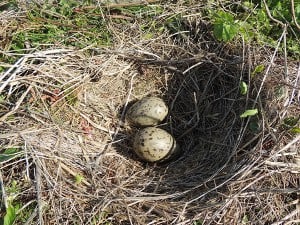Share this article
Seabirds Bring Contaminants to Land Ecosystems: Study
Migratory seabirds carry the marine pollution they ingest at sea back to their nesting sites on land, according to a new study.
“It is yet another example of unintended effects of ocean pollution on species that you might not expect,” said Mark Mallory, a Canada research chair and associate biology professor at Acadia University in Nova Scotia and the lead author of a study published recently in the journal Water, Air & Soil Pollution.

A partially completed Herring Gull nest, one of the semi-colonial birds that transport contaminants to these islands.
Image Credit: Mark Mallory
Mallory has conducted previous studies in the Arctic where it’s easier to see the effects of the chemicals that seabirds bring when they nest inland. The birds generally spread out and feed in a large area of ocean, returning to relatively small colonies where the birds regurgitate food, defecate and sometimes die. All of this contains nitrogen, phosphorous and other chemicals that create “lush patches of vegetation” in the otherwise barren landscape.
“It’s really obvious there that the areas are so starved for nutrients that the areas just light up like beacons with plants,” Mallory said. “It’s like fertilizing your garden.”
Further south in Canada, the ecosystems aren’t as starved for fertilizer and nutrients. But Mallory suspected changes might be occurring in the vegetation and microfauna nonetheless due to the chemicals seabirds were bringing in.
Researchers examined the soil on islands off the coast of Nova Scotia that are inhabited by birds as well as islands with no seabirds. They found that the islands with birds had accumulated and biomagnified chemicals like selenium, zinc and arsenic.
“For quite a few of those islands the concentrations exceeded the soil quality guidelines for the protection of environment health.”

Researcher Lewis Mahon with an eider. He and a team followed different bird species to see whether the birds transported chemical pollution found in the sea into land ecosystems.
Image Credit: Mark Mallory
Mallory said that they didn’t search for other chemicals like DDT or PCBs as the process for checking for these things is more expensive, but he would guess that they were being brought in by the birds as well.
He also said there was a difference between which birds colonized an island in terms of imported pollution. Birds like Arctic terns (Sterna paradisaea) or gull species carry more chemicals because they feed on bigger fish higher up on the food chain than common eiders (Somateria mollissima), which tend to diver deeper to eat mussels and other species lower on the food chain. Chemicals often accumulate in species higher up on the food chain.
Some species such as cormorants absorb so much nitrogen that they drastically change environments where they live, burning out the local vegetation with their feces. It gets so bad that they must move their colonies from place to place.
Mallory conducted another recent study that discovered game waterfowl like mallards (Anas platyrhynchos) and black ducks (Anas rubripes) more commonly associated with land are also ingesting plastic and garbage metal while wintering along coastlines of eastern Canada.
He said that all of these things can pile the stress on birds, which are already facing threats from hunting, oil spills, wind farms and other factors.
“Now we are also stressing them by sublethal levels of contaminants.”
He said the logical next step is to examine whether the chemicals these birds bring in impact other species on the terrestrial food chain including insects or small mammals.
“We know it’s going on, is it having an effect on something else?”
Header Image:
Researchers found that seabirds are transporting chemicals they pick up from the ocean to island habitats off the eastern shore of Nova Scotia.
Image Credit: Mark Mallory








